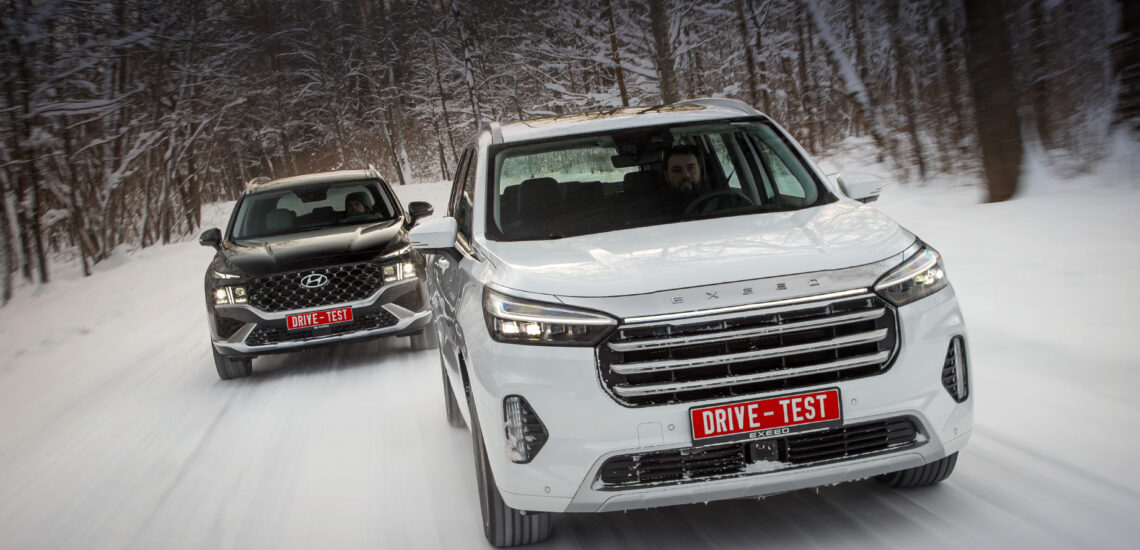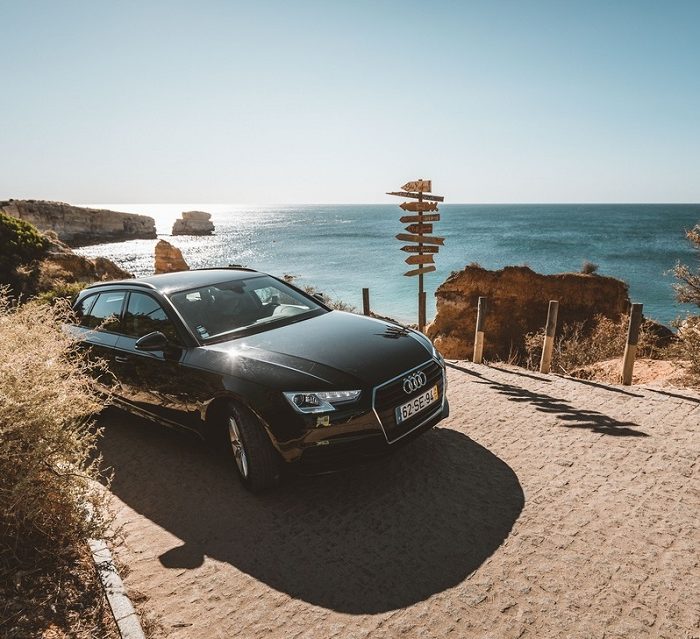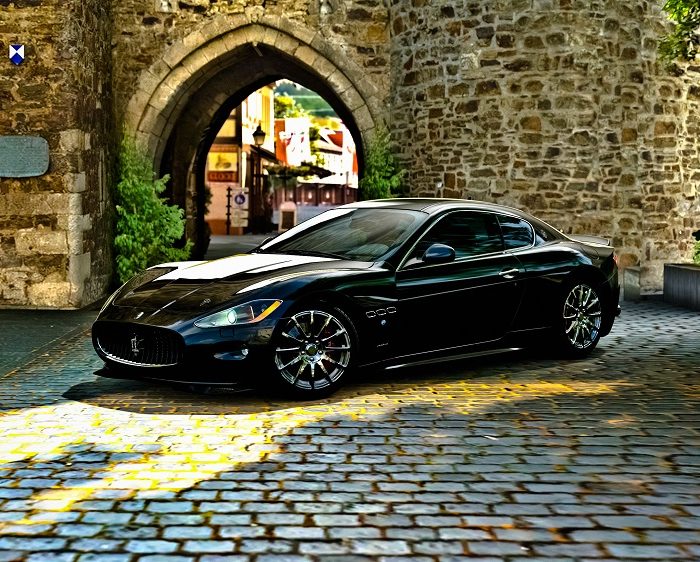Si va a comprar un crossover de gama media, no premium, no debe pasar por alto el Hyundai Santa Fe o el Kia Sorento. El precio recomendado de $39,000-45,500, moderado en estos tiempos, promete potentes y generosas opciones de tracción total incluso con la tercera fila de asientos. Sin embargo, los concesionarios venden automóviles desde un almacén solo con un margen que a menudo supera los $13,000. Y al solicitar tales autos, no se le dan fechas de entrega o precios específicos. ¿Qué sucede si elige un crossover más grande de una marca menos conocida e incluso ahorra dinero? El Exeed VX es una gran alternativa.
Al precio de un SUV mediano, los chinos ofrecen un auto de cinco metros y siete asientos. El Exeed que participa en nuestra prueba de manejo tiene un motor de gasolina 2.0 sobrealimentado de 249 caballos de fuerza. La cartera de Santa Fe incluye motores atmosféricos 2.5 y 3.5, así como un turbodiésel 2.2. Elegimos la última opción. Su potencia es inferior en 50 CV, pero supera al 4.0 de la competencia con un par de 440 N·m vs 385. Hay paridad en otros parámetros: ambos crossover están equipados con cajas de cambios directo y embrague multidisco en el eje trasero.
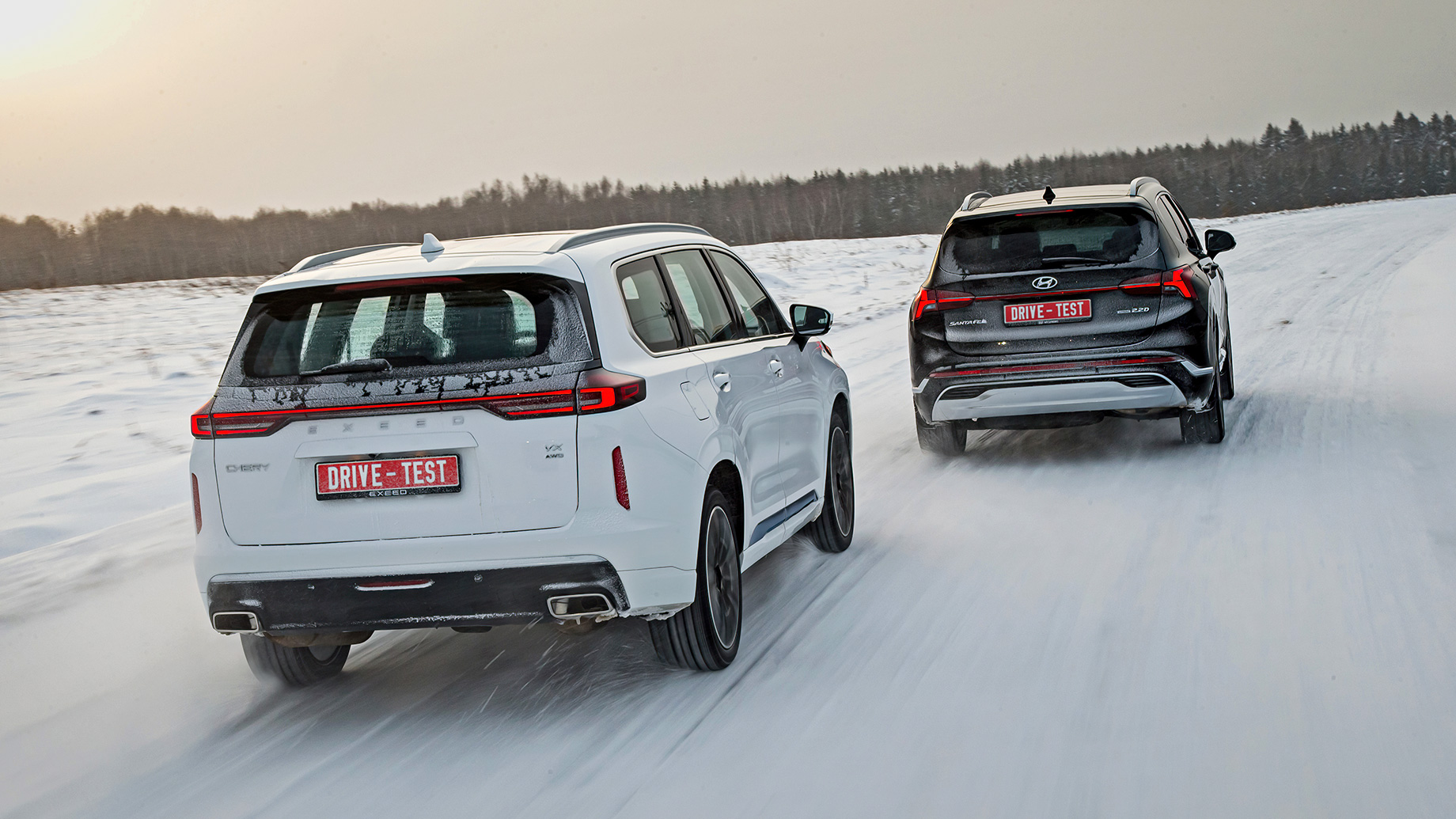
Exeed elevó los parachoques y los alféizares, lo cual es útil. Con sus considerables dimensiones, casi llega a la Hyundai Palisade, pero sigue sin parecer un crossover. Es más bien una mini-van elevada debido a las placas laterales planas y la puerta del maletero transparente. Tampoco está muy bien ensamblado: los espacios entre los paneles de la carrocería son desiguales. El Santa Fe no tiene problemas con eso, y su diseño parece más interesante, gracias a la óptica de doble piso. Las defensas del color de la carrocería y los protectores de arco en relieve le dan un toque de estilo. Esta es una característica del modelo Santa Fe Calligraphy más caro, así como las “estrellas arrojadizas” de aleación de 20 pulgadas.
El interior del Exeed es como un puesto de exhibición de los logros de otras empresas. En la parte superior del panel frontal flexible, se encuentran un par de pantallas de 12,3 pulgadas debajo de un cristal, como en los Mercedes. A continuación se muestra una unidad de control de clima con sensor similar a la de Land Rover. Al menos la compañía Chery tiene una empresa conjunta con los británicos…
La ergonomía es mala. La pantalla táctil central está lejos del conductor, y no hay un control duplicado completo en el túnel central, solo un par de teclas de acceso rápido que lo envían al menú anterior o principal. Además, se inhibe la respuesta de todas las superficies táctiles, y los botones de los radios del volante están tan cerca del borde que accidentalmente los presiona de vez en cuando.
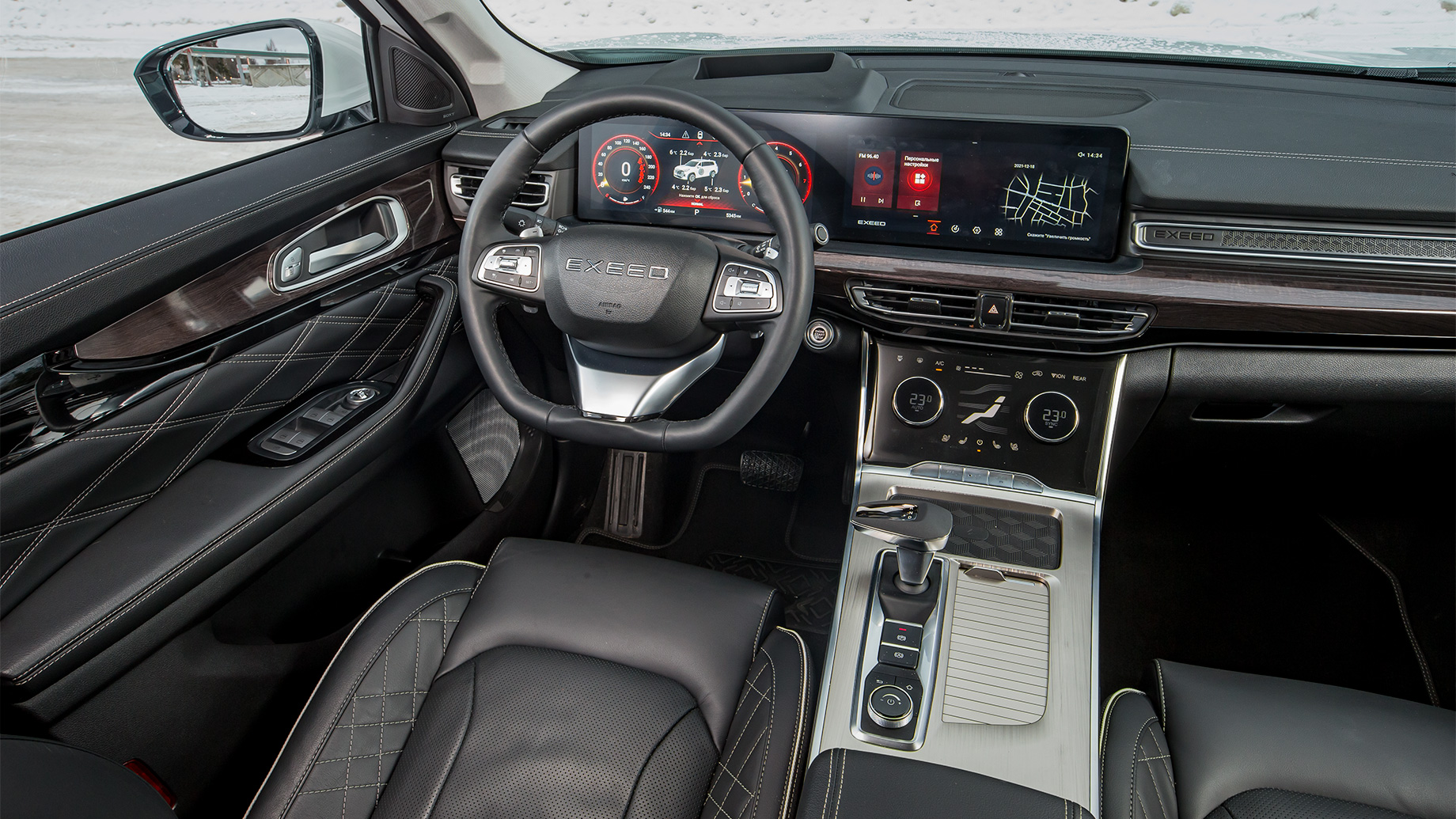
Es más cómodo sentarse en el asiento del conductor: los pilares delanteros están menos inclinados, las aberturas de las puertas son más anchas y altas. El asiento de montaje bajo es agradable: de fabricación sólida, con un soporte lateral discreto y un perfil agradable. Los modestos rangos de ajuste del volante no le impiden sentarse cómodamente sin doblar demasiado las piernas.
El volante Santa Fe, instalado con menos suavidad, se mueve en amplios rangos y puede encontrar una posición cómoda más rápido. La geometría de los asientos resulta ser más cruzada. Su asiento con un relleno flexible, un soporte lumbar más avanzado y una extensión de almohada es más cómodo. En general, el Hyundai está ajustado ergonómicamente, aunque los huecos de las puertas son demasiado estrechos.
Estos huecos de plástico sonoro no dejan olvidar que Hyundai es una marca de masas. Aunque la versión “Calligraphy” hace todo lo posible por distanciarse de tal imagen. Los asientos aquí están tapizados con cuero Nappa de dos tonos, la consola central está decorada con aluminio real y el techo interior está cubierto con alcántara. Dos pantallas de alta resolución con una imagen de alta calidad también corresponden al nivel. El Santa Fe es compatible con los protocolos Apple CarPlay y Android Auto, mientras que el Exeed solo se sincroniza dispositivos Apple.
Es más fácil entrar en la segunda fila de asientos del automóvil chino. Hay notablemente más espacio debajo de las piernas y por encima de la cabeza, el rango de ajuste longitudinal del asiento es más amplio. Hay suficiente ancho para tres pasajeros, y el pasajero en el medio puede poner sus pies en un túnel ancho y bajo. Es una pena que un cojín de asiento cómodo se combine con un respaldo excesivamente convexo. Pero la tercera fila es amigable incluso para adultos de más de 180 cm de altura. Es fácil llegar allí y sentarse cómodamente sin entrar en contacto con los asientos de delante o el techo.
En la versión Santa Fe “Calligraphy”, no se proporciona la tercera fila de asientos, pero está disponible en costosas configuraciones Prestige y High-tech, en un paquete de kit de seguridad Smart Sense. Después de encontrar el automóvil de siete plazas en el concesionario y sentarnos en él, nos retiramos rápidamente. La fila de atrás no solo es estrecha en todas las direcciones, sino que también te obliga a sentarte en una posición incómoda con las rodillas hacia arriba. Un aire acondicionador separado es un pequeño consuelo.
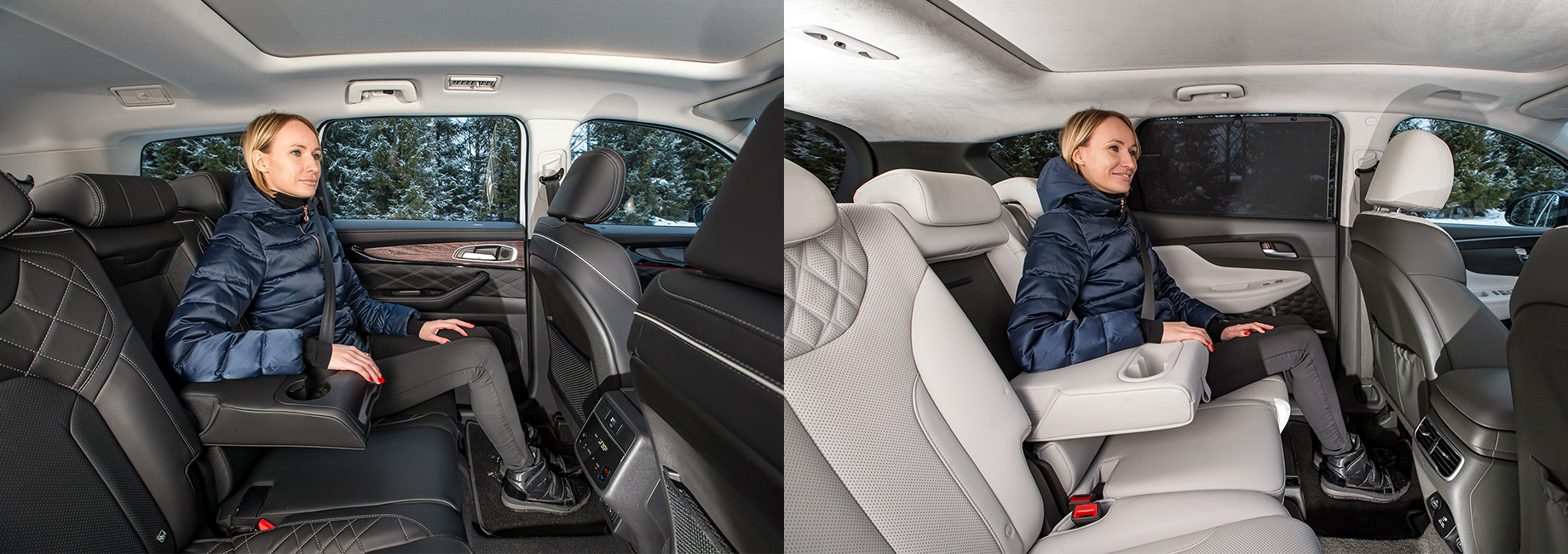
Por el contrario, la segunda fila es bastante competitiva. El ancho de la cabina de Santa Fe incluso supera al “chino”. La “joroba” en el piso es más baja. Hay cortinas en las ventanas. Y lo más importante: el asiento es mucho más cómodo. No te empuja, sino que te abraza suavemente gracias al suave relleno. Queríamos quedarnos dormidos justo en el asiento, especialmente porque el ángulo del respaldo no es peor que el del Exeed.
El Exeed convence como casa, pero no como hogar móvil. La dinámica es buena solo en el papel. Al arrancar lejos del reposo, la electrónica protege los embragues de la caja de cambios robotizada con tanta fuerza que el VX sigue parado cuando el Santa Fe ya está cogiendo velocidad. Y luego la distancia entre ellos solo aumenta. Pero los datos del libro de motor del Exeed prometen una aceleración de 100 km/h en 8,5 segundos frente a los 9,2 segundos declarados para el Santa. Si hay una capa desigual debajo de las ruedas, el VX está aún más atrás. La lentitud de la caja de cambios se suma a la lentitud del embrague, que entra en juego solo después de un largo deslizamiento de las ruedas delanteras.
Es más fácil para el automóvil chino con tracción en las cuatro ruedas acelerar mientras se mueve, pero el Hyundai de alto torque también es más enérgico. Si activas el modo kickdown a 60 km/h en los coches al mismo tiempo, el VX es inferior desde los primeros metros. Y si aumenta la velocidad a partir de 80 km/h, el Exeed comienza a alcanzarla solo después de 120 km/h. Pero a mayor velocidad, el Exeed de gasolina está incondicionalmente a la cabeza: a 130 km/h, el Santa Fe pierde mucho.
La conveniencia del control de tracción del VX es mediocre. No existe un modo de conducción de unidad de potencia óptimo entre los tres disponibles. Los económicos y normales alargan indefinidamente las reacciones al acelerador, mientras que el deportivo, por el contrario, agrava demasiado. Por lo tanto, los dos primeros son adecuados solo para congestión y Sport, para todos los demás casos. E incluso en el modo Sport, el apoyo a la caja robotizada de siete velocidades es mínimo: los cambios son lentos, aunque suaves.
El Hyundai no solamente es más rápido a velocidades legales, sino que también administra mejor sus capacidades. El pedal del acelerador responde mejor en cualquiera de los cuatro modos de conducción propuestos. Además, Comfort, Sport y Smart se pueden usar siempre y en todas partes. La caja robotizada de ocho velocidades funciona precisamente como una de cambio directo, accionando instantáneamente las marchas preparadas de antemano y bajándolas rápidamente. Aunque tiende hacia gamas más altas a bajas velocidades. Esto es tratado por el modo Sport que elimina la séptima y octava marcha de la rotación del motor.
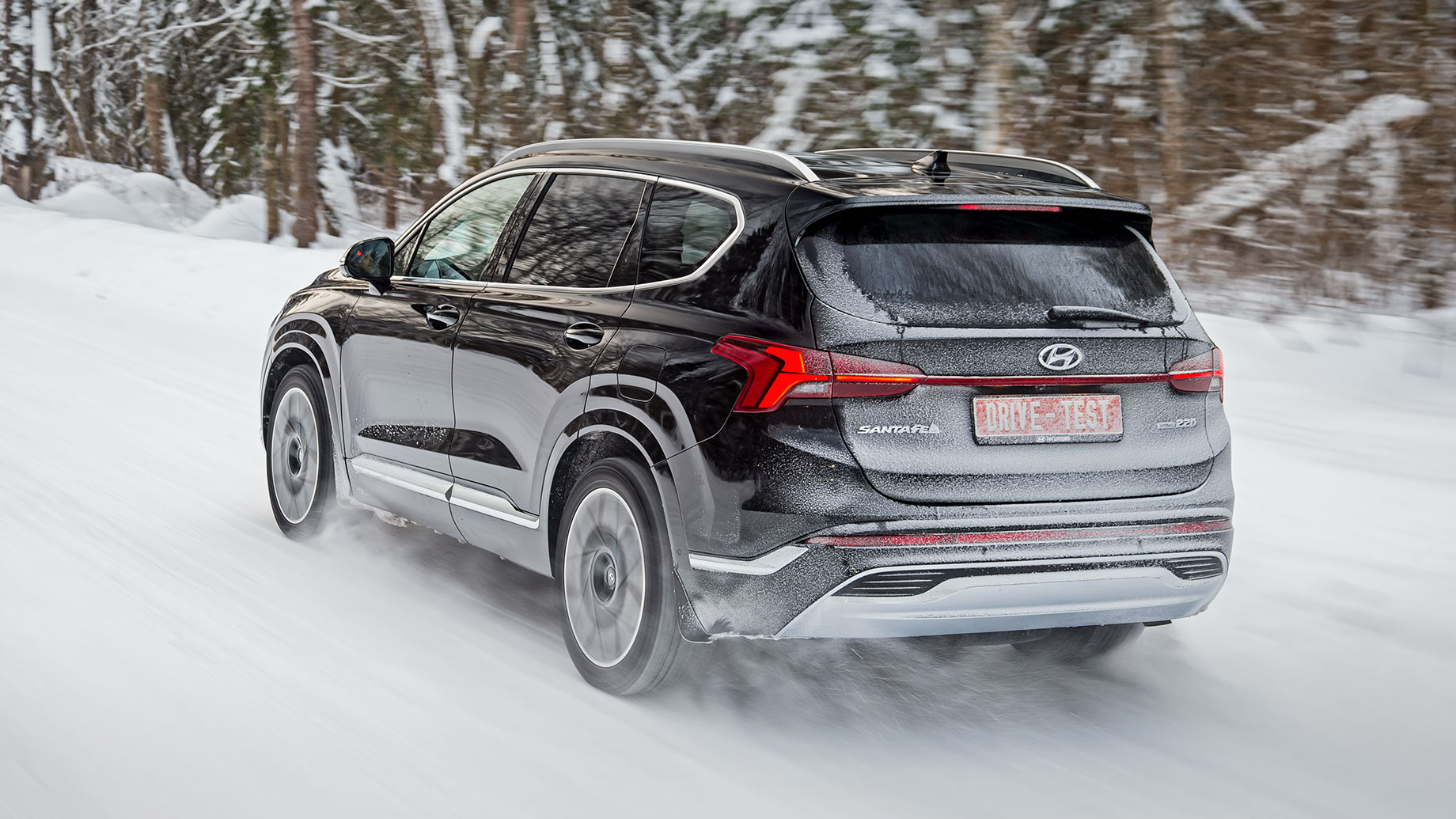
No hemos identificado un líder claro al evaluar la comodidad del viaje. Ambos crossovers son bastante incómodos. El Exeed es un poco más rígido en todos los baches, pero esta diferencia no es esencial. Ambos soportan bien el micro-perfil de la carretera y las “olas suaves”. Pero en grietas, juntas y baches más grandes, aparecen aceleraciones verticales bruscas, no son infrecuentes los golpes que sacuden la carrocería del automóvil.
El comprador del Santa Fe puede al menos elegir ruedas más pequeñas: incluso hay de 17 pulgadas entre las opciones de fábrica. Mientras que el Exeed se suministra en dos niveles de equipamiento, ya sea con ruedas base de 19 pulgadas o con una pulgada más grande que un diámetro. En cualquier caso, los problemas fundamentales del chasis no se solucionarán con el cambio de neumáticos.
Es mejor no conducir a más de 30 km/h en una carretera nivelada llena de baches: ambos autos tiemblan seriamente con el acompañamiento creado por la holgura del interior. Pero incluso aquí las fallas ocurren con más frecuencia en los “chinos”. Sufre más de balanceo longitudinal y lateral. Sí, la caja de cambios y el embrague pueden soportar fácilmente un deslizamiento prolongado. Pero en nieve suelta, el eje delantero se entierra más rápido de lo que se conecta el trasero, y el eje cruzado se convierte en un obstáculo insuperable.
El Santa Fe tiene una mejor capacidad de pase geométrico y un lado inferior más suave. La imitación de bloqueos entre ruedas funciona mejor. Pero incluso con el apoyo de los modos todoterreno, el control de tracción tarda mucho en sacar el coche de la trampa. Eso sí, es necesario hacerlo antes de que el embrague se sobrecaliente, lo que ocurre con bastante rapidez. Ni siquiera pudimos conducir en diagonal hacia la pendiente prevista: la unidad de engranajes trasera dejó de mostrar signos vitales después de dos intentos.
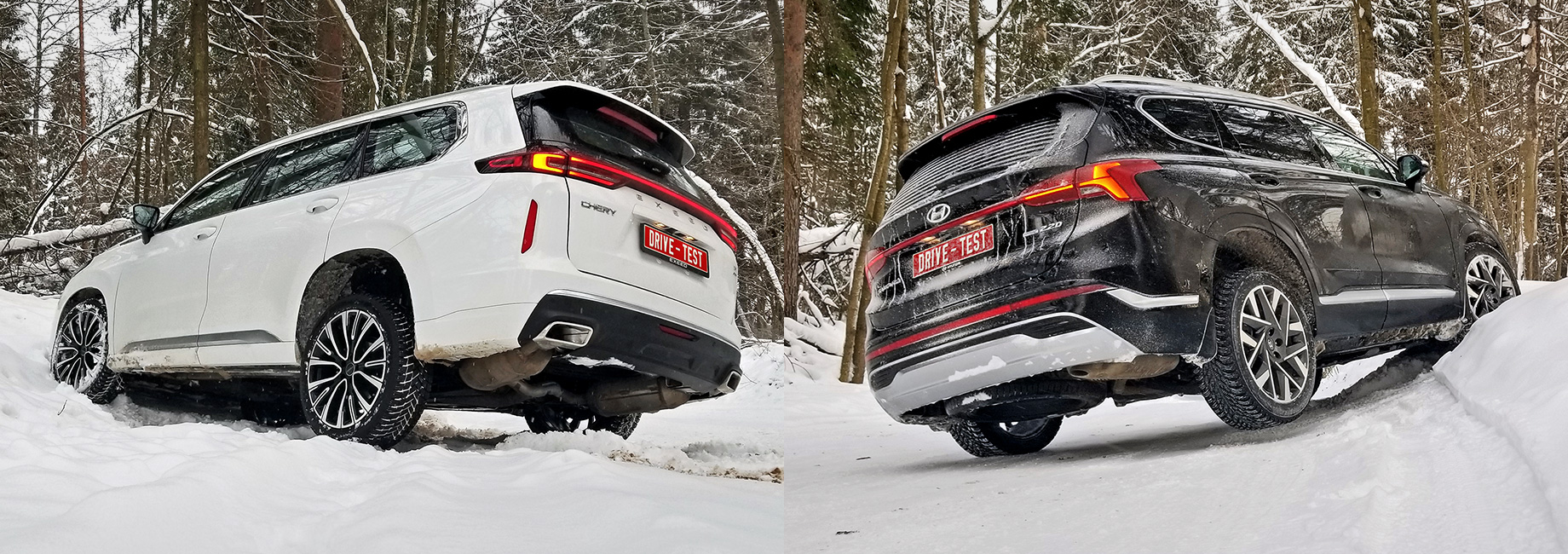
El Santa Fe se siente mejor en una superficie dura: cambia fácilmente un vector de movimiento, rueda moderadamente, reduce la velocidad de manera efectiva. Sin embargo, hay una mezcolanza en el volante, que es típica de la mayoría de los autos coreanos. Mala ductilidad dinámica, esfuerzo de tracción inadecuado: conduce como si tuviera los ojos vendados. Todo esto, además del derrape indiscutible fuera del agarre de los neumáticos, lo desalienta a seguir el ritmo en las curvas. El sistema de estabilidad no conmutable está configurado sin el deseo de brindarle al propietario el placer de conducir en la nieve.
Nos gustó más el Exeed en una superficie resbaladiza, gracias al funcionamiento sencillo y predecible de la transmisión y la electrónica de seguridad que se puede desconectar. Los frenos funcionan bastante bien, aunque se podría reducir el recorrido del pedal. Sobre asfalto, el VX da la impresión de un producto crudo, incluso en el contexto del anodino Santa. Flaco, inestable. Y hay algo raro en el volante en general. De vez en cuando, aparecen volantes de torsión, como si un compañero no del todo sobrio estuviera conduciendo el automóvil simultáneamente, dando pistas al azar.
En resumen, el Exeed no es muy bueno en cuanto a características de conducción. La unidad de potencia, dirección y suspensión piden reconfiguración. En ausencia de un control de tracción de alta calidad, la tracción total es impotente incluso en condiciones todoterreno livianas. La ergonomía tampoco es perfecta. Al mismo tiempo, el motor es suficiente para toda la vida, el confort acústico es superior al del rival. Si no persigue la versión superior, la comodidad de conducción se pondrá al día ligeramente. Por $45,500, obtienes no solo un interior decente, siete asientos de tamaño completo y una cajuela grande, sino también una garantía de siete años con un límite de 200,000 km. Por supuesto, hay muchas reservas en él, como en el coreano de tres años. Pero dada la situación del mercado, el VX no está perdido.
El Santa Fe es generalmente más agradable. Pero por el mismo dinero, puede contar con una combinación de un motor 2.5 de potencia débil con un equipamiento rico, o con un motor diésel de alto par en relación con la configuración ascética de estilo de vida. Los precios de la versión Calligraphy alcanzan los 65.700 dólares. Al mismo tiempo, todas las modificaciones, independientemente del precio, están plagadas de poca suavidad, la debilidad de la tracción total y la dirección mal ajustada.
Esta es una traducción. Puede leer el original aquí: https://www.drive.ru/test-drive/exeed/hyundai/61cc2ead6966c12d74e0e20a.html

Publicado Febrero 17, 2022 • 10m para leer

